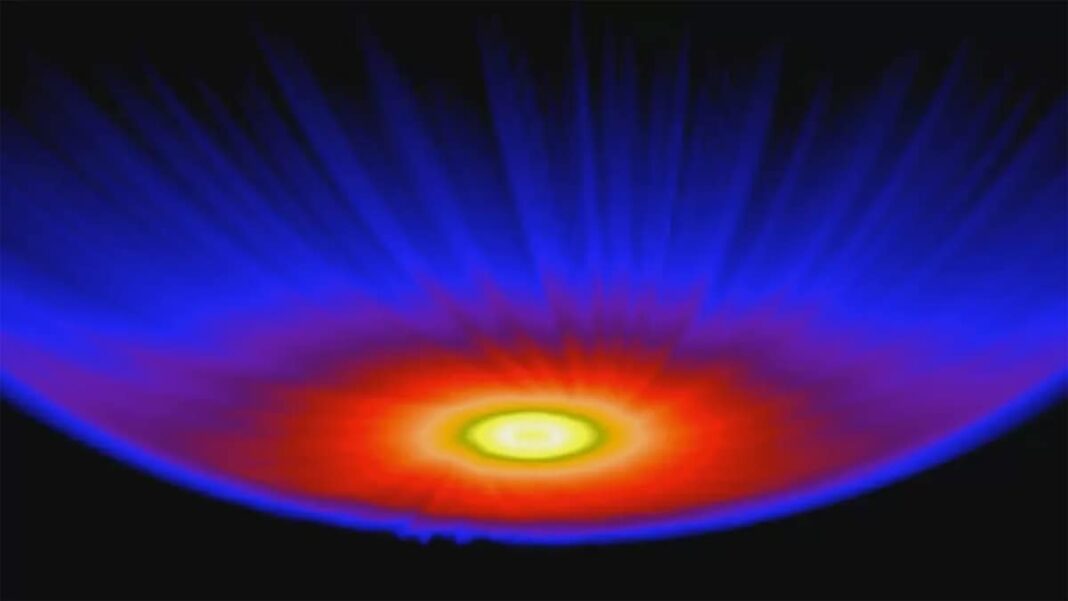Astrosphere Discovery Unveils Secrets of Stellar Evolution
Astronomers have made a groundbreaking discovery, unveiling an astrosphere around a star similar to the Sun, marking a significant milestone in understanding stellar evolution. This finding, shared during the 25 Years of Science with Chandra symposium on December 3, 2024, offers a rare glimpse into the early conditions of stars like our own Sun. The astrosphere, described as a bubble of ionized gas formed by stellar wind, plays a crucial role in shielding planetary systems from cosmic radiation and has provided valuable insights into the formation of these protective structures.
The Story So Far
In a galaxy far, far away, the star HD 61005, affectionately known as "The Moth" for its unique wing-like dust disk, took center stage in this cosmic drama. This star, with attributes resembling those of our Sun, became the focal point of a groundbreaking investigation that has left astronomers and stargazers alike in awe. Its rapid movement through a dense interstellar gas cloud, coupled with its youthful age of 100 million years, offered a perfect canvas for studying astrospheres and unlocking the secrets of stellar evolution.
Key Target: HD 61005, Known as "The Moth"
HD 61005, an enigmatic star with a wing-like dust disk, captivated researchers and space enthusiasts alike with its intriguing characteristics. Its movement through an interstellar gas cloud at breakneck speed, combined with its resemblance to the Sun in size and mass, made it an ideal subject for this cosmic exploration. The youthful vigor of stars like HD 61005, emitting powerful stellar winds, provided a unique opportunity to study astrospheres and delve into the protective mechanisms that govern stellar systems.
X-ray Data Unveil Unexpected Details
NASA’s Chandra X-ray Observatory captured mesmerizing images that revealed a halo of X-rays enveloping HD 61005, extending far beyond the Sun’s heliosphere. Contrary to expectations, the astrosphere displayed a spherical shape, defying conventional wisdom and challenging our understanding of stellar dynamics. This unexpected discovery sheds light on the intricate interplay between a star’s intense wind and external pressures, offering a glimpse into the complexities of astrospheric structures.
Insights into Solar Evolution
The findings from this groundbreaking discovery are not just limited to astrophysics; they hold profound implications for understanding the early stages of our Sun and its protective influences on Earth. By unraveling the mysteries of astrospheres, scientists hope to gain valuable insights into the habitability of planets orbiting stars with similar properties, paving the way for a deeper understanding of the cosmic ballet that shapes our universe. This study represents a leap forward in our quest to comprehend the protective role of astrospheres across stellar systems, offering a tantalizing glimpse into the cosmic tapestry that binds us all.
Conclusion
In conclusion, the discovery of an astrosphere around a star akin to the Sun marks a significant milestone in our understanding of stellar evolution. This groundbreaking finding not only sheds light on the protective mechanisms that govern planetary systems but also offers valuable insights into the early behavior of stars like our own Sun. As we continue to unravel the mysteries of the cosmos, discoveries like these pave the way for a deeper appreciation of the intricate dance of celestial bodies that shape our universe.
Frequently Asked Questions
- What is an astrosphere?
- An astrosphere is a bubble of ionized gas formed by a star’s stellar wind, acting as a protective shield around stars.
- Why is HD 61005 known as "The Moth"?
- HD 61005 earned the nickname "The Moth" due to its distinctive wing-like dust disk that resembles the wings of a moth.
- What role do astrospheres play in shielding planetary systems?
- Astrospheres protect planetary systems from cosmic radiation, creating a safe environment for potential habitable worlds.
- How did the X-ray data from NASA’s Chandra Observatory contribute to the discovery of the astrosphere?
- The X-ray data revealed a halo of X-rays around HD 61005, extending far beyond the Sun’s heliosphere, providing crucial insights into the structure of the astrosphere.
- What are the implications of this discovery for understanding solar evolution?
- This discovery offers valuable insights into the early behavior of stars like the Sun, shedding light on the protective mechanisms that influence planetary habitability.
- Why is studying astrospheres around stars like HD 61005 important?
- Studying astrospheres around stars like HD 61005 provides crucial information about the protective mechanisms that govern stellar systems, offering insights into the evolution of planetary environments.
- How does the spherical shape of the astrosphere around HD 61005 challenge previous assumptions?
- The spherical shape of the astrosphere around HD 61005 defies conventional expectations, suggesting a more complex interplay between a star’s wind and external pressures.
- What makes HD 61005 an ideal subject for studying astrospheres?
- HD 61005’s resemblance to the Sun in size and mass, coupled with its youthful age and powerful stellar winds, makes it a perfect candidate for studying astrospheres and early stellar evolution.
- What broader implications do these findings have for understanding the habitability of exoplanets?
- By studying astrospheres around stars like HD 61005, scientists can gain valuable insights into the habitability of exoplanets orbiting similar stars, expanding our understanding of potential life-supporting environments.
- How does this discovery contribute to our overall understanding of stellar systems and cosmic evolution?
- This discovery represents a significant milestone in unraveling the mysteries of astrospheres and their protective role in stellar systems, offering a deeper appreciation of the cosmic forces that shape our universe.
Tags: Astrosphere, HD 61005, The Moth, Stellar Evolution, Chandra X-ray Observatory, Sun, Stellar Wind, Habitable Planets, Exoplanets, Cosmic Radiation.
- This discovery represents a significant milestone in unraveling the mysteries of astrospheres and their protective role in stellar systems, offering a deeper appreciation of the cosmic forces that shape our universe.

